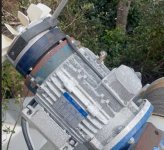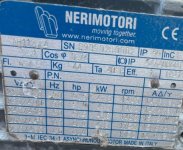lostcontrol
Lifetime Supporting Member
Hi Team,
We have had an old VSD fail (15+ years old) & replaced it with a modern inverter.
The brake on this motor is AC as opposed to a DC which we see mostly these days.
When the replacement VSD is started, an earth leakage fault is triggered. When this detection is disabled, the fault is changed to high DC link.
The brake appears to operate ok electrically & mechanically.
If the brake is released manually, the VSD operates as expected with no issues.
We don’t think it is a bad brake as visually & audibly, it looks good.
Current conclusion is the modern electronics are more sensitive & less output filtering are the issue, but even still it should not fault like this
Any thoughts.?
We have had an old VSD fail (15+ years old) & replaced it with a modern inverter.
The brake on this motor is AC as opposed to a DC which we see mostly these days.
When the replacement VSD is started, an earth leakage fault is triggered. When this detection is disabled, the fault is changed to high DC link.
The brake appears to operate ok electrically & mechanically.
If the brake is released manually, the VSD operates as expected with no issues.
We don’t think it is a bad brake as visually & audibly, it looks good.
Current conclusion is the modern electronics are more sensitive & less output filtering are the issue, but even still it should not fault like this
Any thoughts.?








